When invasive Eurasian watermilfoil comes to a lake, conventional wisdom says you can kiss wildlife habitat and clean water goodbye.
Conservationists often must resort to using chemicals to control the aquatic weed. But those chemicals can imperil the very wildlife that weed control is supposed to protect.
At Lulu Lake in southcentral Wisconsin, though, scientists may have found the Eurasian watermilfoil’s worst enemies: scuba divers and snorkelers.
Hand picking by underwater crews, followed by restoration, may offer one of the most effective ways of controlling this aquatic nuisance. And it’s so simple, cost effective and non-toxic that lakeside home owners and other citizen groups can undertake weed removal projects.
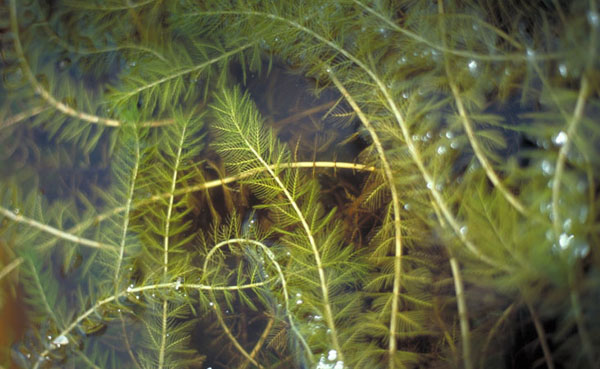
The Problem: Choking Lulu Lake
Lulu Lake, near East Troy, Wisconsin, is one of the pretty North Country lakes that just seems to call for a canoe and a bass fishing rod. It’s also part of the extraordinarily diverse Mukwonago Watershed, home to some 66 species of fish and 14 species of mussels.
The 95-acre, 46-foot deep lake was carved by glaciers and is ringed by wetlands, filtering clean drinking water and providing flood control.
It’s an idyllic spot, to be sure. But beneath the surface, a weedy problem lurks.
The lake is connected by a river to another lake with a serious Eurasian watermilfoil infestation. Pontoon boats drift from one lake to the next, bringing with them the weed.
Like many weeds, Eurasian watermilfoil is a survivor. One tiny piece cut from the main plant can land on the bottom of a lake and sprout. Soon, it will form a dense, nearly impenetrable mats. It chokes the lake, making it inhospitable for wildlife and people.
Eurasian watermilfoil began showing up in Lulu Lake at a point where the pontoon boats have congregated in recent years. Could conservationists stop it there before it spread to other parts of this lake?
“Is the presence of Eurasian watermilfoil a sign we’re losing Lulu Lake?” asks Jerry Ziegler, Mukwonago River land steward for the Conservancy. “That would be such a tragedy. It’s one of the cleanest water sources in southern Wisconsin. It’s a beautiful place that people appreciate. We had to do something to get ahead of this problem.”
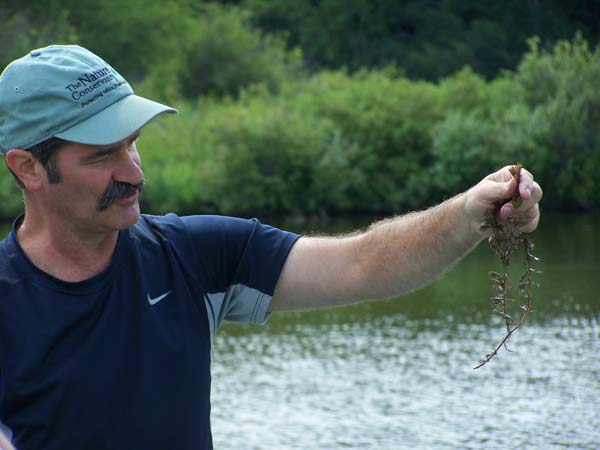
The Obstacle: Cures Worse than the Weeds?
Faced with an Eurasian watermilfoil infestation, many lake managers turn to chemicals, sometimes including 2,4-Dichlorophenoxyacetic acid (commonly called 2,4-D).
But this raises another issue: 2,4 D can pose a threat to fish, mussels and amphibians. In short, the cure for this conservation threat turns out to be a conservation threat. The pesticide also poses health risks to swimmers in lakes.
Some lakes send large mechanical aquatic weed harvesters up and down channels, pulling out the weeds. But break pieces off Eurasian watermilfoil and it just spreads more Eurasian watermilfoil.
“That approach is really like throwing gas on a fire,” says Ziegler. “It works for a couple of weeks. Then the pieces reroot and come back with dense mats again. Often, lakeside home owners get frustrated and end up using chemicals.”
Could there be a way to control the weeds while not using chemicals or making the problem worse?
“I was determined we could hand harvest Eurasian watermilfoil,” Ziegler says. “But how could we possibly make that work?”
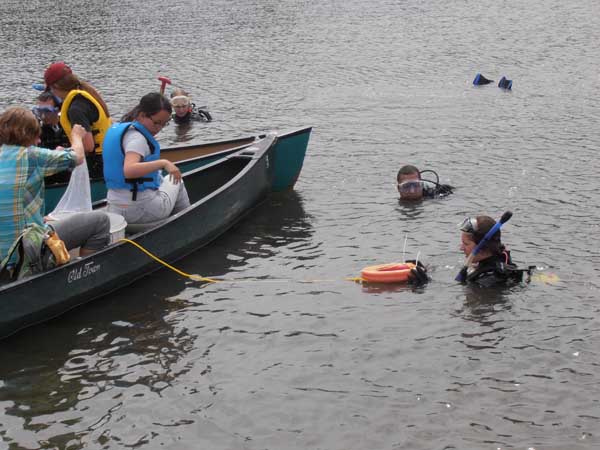
Solution: Diving for Invaders
Ziegler teamed up with Dr. Tim Gerber, a biology professor and aquatic plant researcher with the University of Wisconsin-La Crosse, to design an experiment determining the effectiveness of hand harvesting the weeds and then restoring the area with native vegetation.
Ziegler spends a lot of time working with school and community groups, so he had a ready supply of eager weed pullers. Interns from the Conservancy’s Leaders in Environmental Action for the Future (LEAF) program also assisted.
Eurasian watermilfoil, of course, has to be harvested underwater. Enter the scuba divers and snorkelers.
First, scuba divers are trained in the difference between native species and invasives. The divers must then very carefully approach the weed patches and pull it without stirring up the mucky lake bottom. If they kick up silt, they won’t be able to see well enough to harvest for hours.
It’s laborious, but a slow, careful approach can yield large amounts of weeds. In shallow water, snorkelers collect the plant in a similar way.
Surely hand pulling results in some broken stems drifting away. Won’t those just land on the bottom of the lake and resprout?
Ziegler and Gerber have this covered. On the surface, they have crews floating with modified swim noodles and large nets. Any weeds fragments that bob to the surface are netted and brought to the boat.
While it’s too early in the experiment to know, initial results are promising. Crews harvest hundreds of pounds of the weed annually, but it has not spread widely in the lake.
“What would Lulu Lake look like if we had done nothing?” asks Ziegler. “Eurasian watermilfoil would be choking the lake by now. No question.”
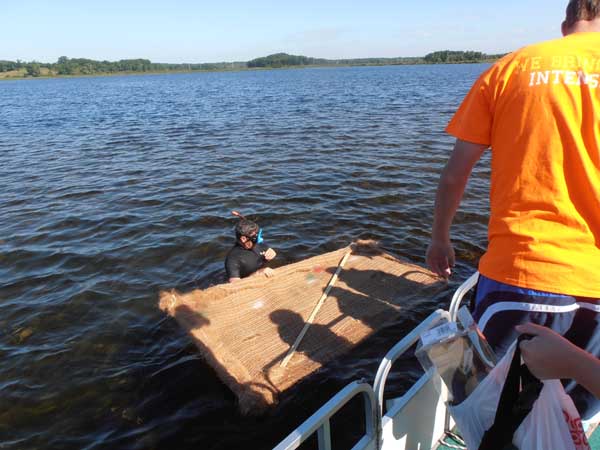
A Second Step: Coconut Mats and Native Plants
Just removing the weeds isn’t enough, though. “We’re pulling so much vegetation, we’re essentially creating these large dead zones,” says Ziegler. “The invasives will just move right back in unless we undertake some active restoration.”
Gerber is leading an experiment to test the most effective methods for restoring native plants. Ziegler and his team are using biodegradable coconut fiber mats with snippets of native species planted into the mats.
The mats degrade in two years, leaving behind what researchers hope is a thriving community of aquatic plants.
Gerber is also growing native plants with and without mats in the greenhouse, then weighing the dried plants to see how much biomass can be achieved with each method.
“We’re hopeful that a healthy native plant population, once it’s reestablished, can outcompete Eurasian watermilfoil,” says Ziegler.
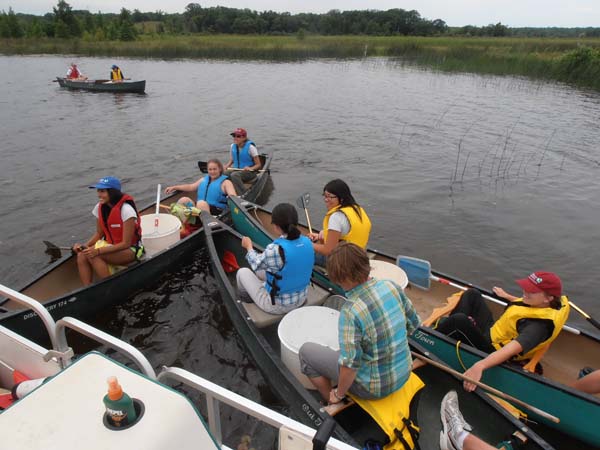
The Future: An Ounce of Prevention
These efforts offer great promise, and already lakeside homeowners have expressed interest in the methods. They wanted something that was low-cost and that didn’t require extensive permits or technology.
“A lot of people didn’t think there was an alternative to pesticides,” says Ziegler. “We wanted to show them that they could do this on any lake.”
But there remains one big issue: even this method ultimately requires hard work every year, and it won’t ultimately succeed if boats keep bringing more and more weeds into the lake.
Educating boat owners, Ziegler believes, is vital. He sees pontoon boaters enter the lake and reverse their engines, dislodging weeds – despite signs asking them not to do this.
He has students monitoring boats, he’s distributing educational materials, he’s speaking to homeowners, boaters and anglers. But ultimately, Ziegler says the most effective outreach may be the teams of snorkelers and surface crews picking the weeds. Those groups often consist of students who are eager to play a role in preserving the lake.
“Kids will educate their parents,” he says. “They can help us spread our message. We’re offering a non-chemical solution but we need the public’s help. And they can help, simply by cleaning their boats and making sure they’re not bringing Eurasian watermilfoil to new lakes. People in Wisconsin love their lakes. This is an easy way they can protect them for the future.”
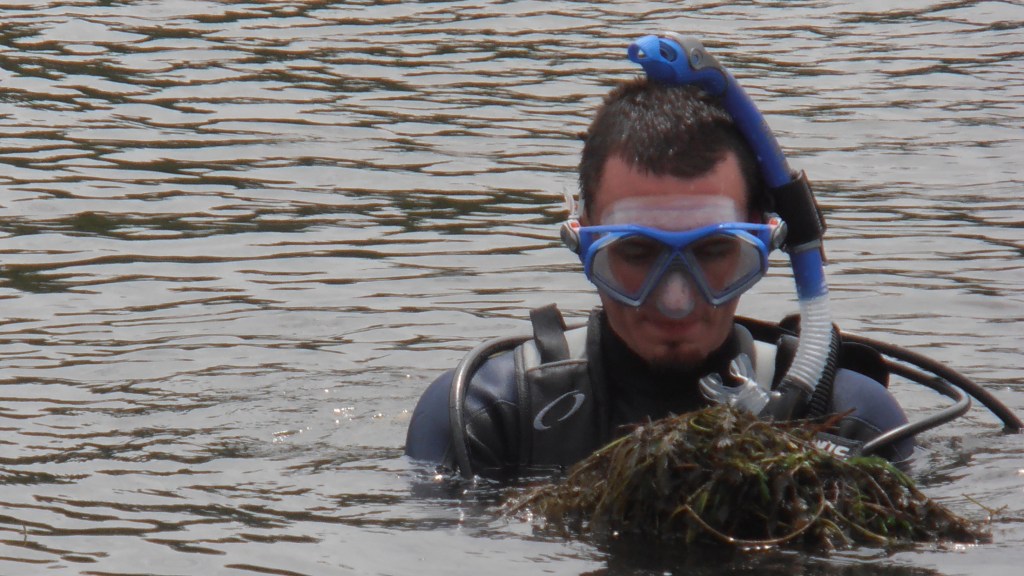



I have a Family Summer home in Twin Lakes , Wisconsin for the bast 55 Years . For the past several years the y have been using pesticides to kill the Eurasian Watermilfoil in the Lakes , Mary and Elizabeth . My section of the lakes has been treated every year and has not improved. I recently volunteered on the Lake Reclamation Committee to seek other ways to treat the lakes. I snorkel in the lake and this looks like a good alternative. I would be interested in how it was organized and what costs were involved . This committee Involves the Village Mayor and board and for approval. I have suggested havesting in the past and have not gotten support. I welcome any suggestions.
Prevention is better. Could a trip through a boat wash (like a car wash)or boat licensing for a particular water area help? Could either of these systems be made to work in some areas? I live very close to Lake Erie…
For those interested in hand harvesting milfoil or other invasive, exotic aquatic plants; there is a nice You Tube video (see link below) of the process and things to think about if you plan to hand harvest.
http://www.youtube.com/watch?v=CfsEDyAwQP4
Great to hear about such a simple, yet powerful technique can work just as well as potentially toxic chemicals.
Also great to hear about the LEAF interns assisting. I know they love working with Jerry Ziegler and learn so much every year!
Thanks Matt. As you know invasive weeds are an ongoing challenge here in Idaho also.
Great blog on the work the Conservancy is collaborating with UW La Crosse on to battle Eurasian water milfoil at Lulu Lake and the importance of students and interns to this effort.